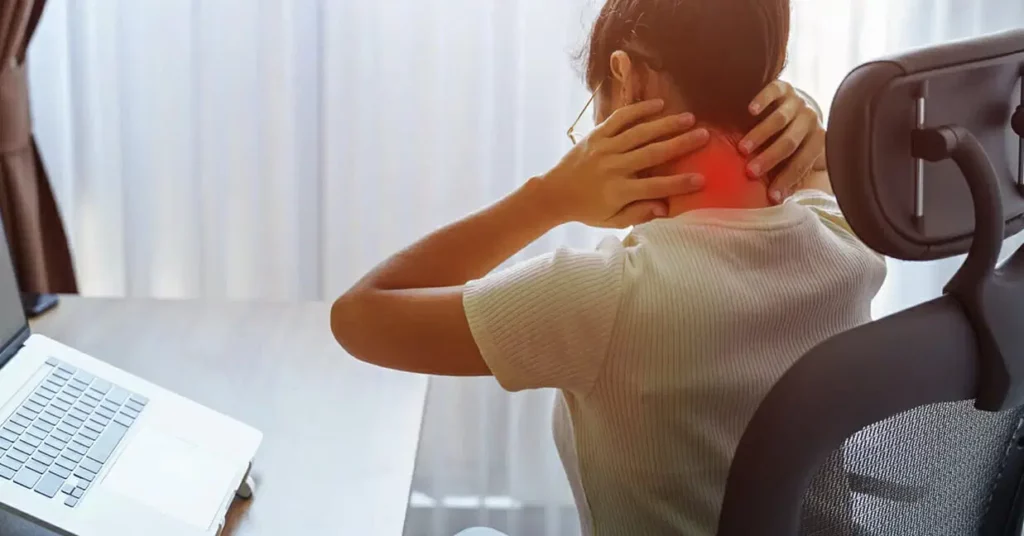The Pain You Didn’t Sign Up For
When the COVID pandemic hit, remote work became the norm, but few had the time or resources to set up truly ergonomic workspaces. Kitchen counters turned into desks, beds became workstations, couch corners became corner offices, and dining chairs replaced office seating. While the shift to remote work has offered flexibility and convenience, it has significantly cost our health. Up to 61% of remote workers report experiencing new or worsening musculoskeletal symptoms, including back pain, neck tension, and wrist strain (Shariat et al., 2021). A study by Oakman et al. (2020) further highlighted that poor ergonomic conditions in remote settings are linked to increased fatigue and decreased productivity. These issues are not just minor discomforts — poor posture and inadequate workstation setups are directly associated with musculoskeletal disorders (MSDs), which account for nearly one-third of all work-related injuries, according to the CDC. This growing concern underscores the need for proactive solutions like Virtual Ergonomic Workplace Analysis (EWA), which help individuals identify risk factors early and make evidence-based improvements to their workspace.
Ergonomic Workplace Analysis — A Smarter, Scientific Approach to Workplace Health
At Recoup Health, our medical, ergonomic, and rehabilitation experts recognized the widespread ergonomic risks emerging from prolonged remote work and suboptimal workstation setups early. In response, using clinically validated tools, we developed the Virtual Ergonomic Workplace Analysis (EWA), a comprehensive, evidence-based digital platform designed to assess and improve posture, workstation alignment, and musculoskeletal health.
EWA integrates three foundational methods that are widely acknowledged in occupational health research:
ROSA – Rapid Office Strain Assessment
Initially developed by researchers in Canada, ROSA is a structured observational method used to identify and score risk factors associated with computer-based office workstations. It evaluates parameters like chair height, armrests, monitor position, and peripheral usage to generate a composite risk score. The ROSA system is valid and reliable for assessing ergonomic risk levels in office environments (Sadeghi et al., 2015).
Nordic Musculoskeletal Questionnaire (NMQ)
The NMQ is a standardized self-report tool used globally to assess the prevalence and severity of musculoskeletal symptoms in various body regions which is instrumental in ergonomic research for establishing correlations between work conditions and musculoskeletal disorders (MSDs). The tool has been extensively validated and widely used in field and clinical studies (Kuorinka et al., 1987).
Photographic Posture Analysis
Visual ergonomic assessment through guided photography allows for the remote identification of postural deviations, workstation misalignments, and improper body mechanics. Studies have shown that posture analysis based on photographs is a valid, cost-effective, and repeatable method for ergonomic risk assessment in clinical and non-clinical settings (Dockrell et al., 2015).

FIG 1: ROSA Scoring

FIG 2: Nordic Musculoskeletal Questionnaire

FIG 3: Photographic Analysis
These tools collectively empower Ergonomic Workplace Analysis to produce personalized ergonomic recommendations that licensed specialists in occupational and rehabilitation medicine medically review. Each report considers individual characteristics such as height, weight, dominant hand, and workstation layout, ensuring the advice is scientifically sound but also practical and actionable.

FIG 4: Recording the observations

FIG 5: Giving Recommendations
By fusing clinical expertise with scalable technology, EWA bridges the gap between traditional ergonomic consultation and modern digital wellness, providing accessible, accurate, and impactful solutions for today’s evolving work environments.
Applying Ergonomic Workplace Analysis: What It Looks Like
Consider the case of a 23-year-old remote software engineer who, like many, began experiencing wrist pain and lower back discomfort after long hours hunched over his laptop. Through the Ergonomic Workplace Analysis platform, he identified key issues in his setup: a chair that was too low without foot support, a screen positioned below eye level, and rigid, non-cushioned armrests. With a few simple, personalized adjustments like raising his chair, adding a footrest, switching to a wireless keyboard and mouse, and elevating his screen, the results were remarkable. Within just two weeks, he reported a 70% reduction in discomfort, noticeable improvement in posture, and no missed workdays. It didn’t take expensive equipment but just the right guidance. This example illustrates how small, evidence-based changes can lead to significant improvements in everyday comfort and long-term musculoskeletal health.
Why Ergonomics Isn’t Just for the Office Anymore
The boundary between professional and personal space has permanently blurred, and so has our attention to proper workplace ergonomics. According to recent data, 45% of the global workforce now operates in a hybrid model, alternating between office settings and home-based or mobile workstations (Gartner, 2023). Yet, despite this shift, only 18% of home office setups meet basic ergonomic standards (Menéndez et al., 2021). The disconnect has real consequences like when you’re working from a dining chair, balancing a laptop on your knees, or hunched over a coffee shop counter, your body absorbs the strain. Whether you’re a founder building from your sofa, a freelancer bouncing between cafés, or a full-time employee navigating inconsistent setups between home and HQ, your physical environment directly impacts your comfort and focus, energy levels, and long-term musculoskeletal health. Poor ergonomics don’t just cause aches, but they also lead to reduced productivity, mental fatigue, and in some cases, chronic pain or injury. As work becomes more fluid, ergonomic support must evolve, meeting professionals wherever they are, not just in the office.
Ready to Work Pain-Free? Get your Ergonomic Workplace Analysis Now !
You don’t need special equipment, clinic visits, or guesswork, just 10 minutes and a few photos of your workspace.
✅ Clinically validated assessment tools
✅ Personalized recommendations from real medical experts
✅ No downloads, no sensors — just smart, science-backed insights
✅ Ongoing support to keep your setup optimized
Start your free EWA assessment today → https://ewa.recoup.health/
📞 Have questions? Call us at 080-69274900
🌐 Learn more at www.recoup.health




